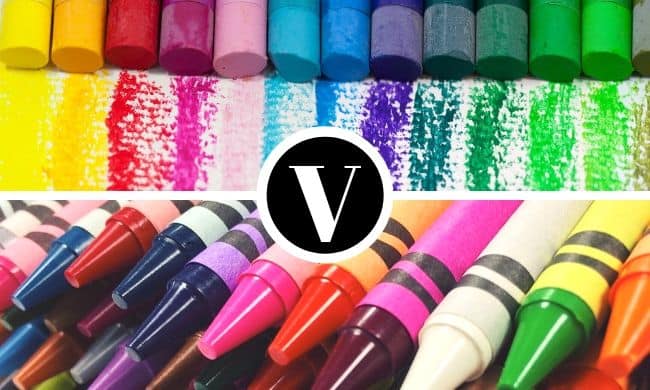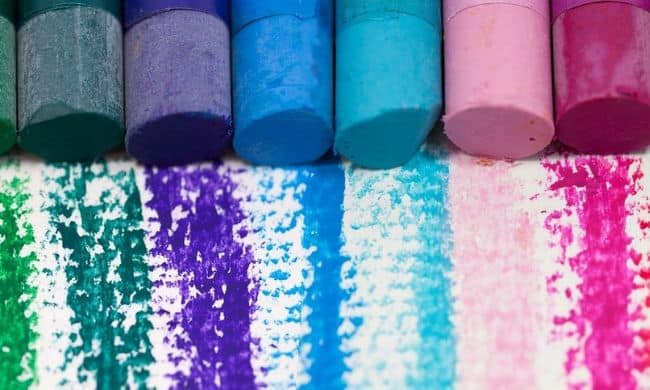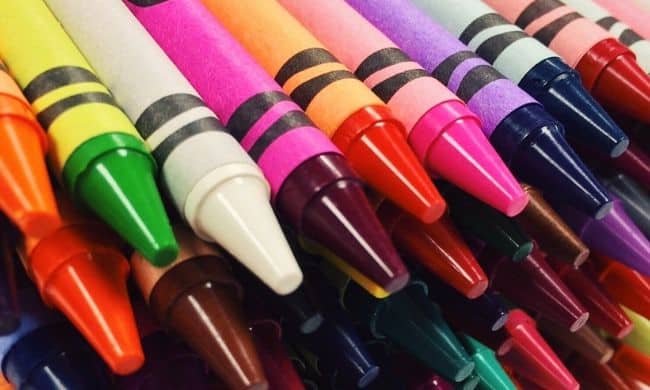Are oil pastels different from crayons or can you use them the same way and get similar results? I have looked into the similarities and the differences between these two much-loved popular mediums.
There are several key differences between oil pastels and crayons. These include, what they are made from, how they melt, price and how toxic they are, etc. Below I share some of my findings on these differences.
Both have their place, however, oil pastels are a better quality medium to work with and have a richer more refined finish.

Is An Oil Pastel a Pastel Crayon?
There are several types of crayons there are the traditional waxed crayons that we used as kids. There are also chalk crayons.
The definition of a crayon is “a pencil or stick of colored chalk or wax, used for drawing.” So as oil pastels are made with wax this makes some oil pastels crayons.
While oil pastels can also be crayons there are many differences between them and the traditional wax crayon.
Pastel Crayons And Oil Pastels Are Made Of The Following
- Crayola Crayons are made of a binder of paraffin wax and color pigment.
- Oil pastels are made from a pigment mixed with a non-drying oil and wax binder. (Source Wikipedia)
Are Oil Pastels Toxic?
- Some types of oil pastels can contain toxic pigments. This isn’t an issue unless you breathe it in. (See the differences of oil pastels for kids below)
- While crayons are typically made for children so are made to be nontoxic.

Crayons V Oil Pastels Quality
- Oil pastels have a better-finished quality than crayons. Their colors are also much more vibrant.
- Oil pastels are meant to blend and they blend much better than crayons. You can easily mix and blend them together.
- Crayons are also much harder than oil pastels. They do not blend well at all.
- When you are painting with pastels they can get all over you. Crayons do not do this.
- You can layer oil pastels while wax crayons do not really layer anywhere near as well.
- Oil is overall much better to work with and apply than a crayon.
What Has More Flexibility Oil Pastels or Crayons?
Crayons are less flexible on what surfaces you can paint on. They are meant to be used only with paper. (Although I know many a parent that will heartily disagree with that assessment lol. I’m fairly sure they also work on walls!)
Oil pastels are very flexible on what you can paint them on. They will work on many different surfaces including paper, wood, and metal, etc. if the surface is properly prepared.
The Differences Between Oil Pastels V Crayons For Kids

The main difference between crayons and oil pastels when getting them for kids is that crayons are usually designed for kids so they are created nontoxic. However, oil pastels can have some toxic elements to them.
If you want to buy oil pastels for your kids you can get kid-friendly ones. Get the ones that have the CE mark on them.
Or they will have an AP safety mark to show safety standard ASTM D4236. Which shows that the art materials are nontoxic.
Oil Pastel Crayons Price
Prices range depending on several things like the quality of the item, where you buy it, and if there are any offers. This makes it very difficult to compare like for like. However overall oil pastels are more expensive than crayons. This is especially true if you buy artists’ quality pastels.
Do Pastels Melt Like Crayons?
No oil pastels do not melt like crayons. There are several differences in the makeup that makes melting them react differently. I have covered each one below.
Safety Note: I do not recommend melting either as that is not what they are made for and it should not be needed. However, below I have covered in more detail how they melt and the effects that it has for those that have asked.
How Do Crayons Melt? And Should You Melt Them For Art?
I have chosen Crayola as an example as they are a quality crayon in the UK.
The Crayola Crayon melting point is between 120 to 147 degrees Fahrenheit. (49C-64C). And they soften at around 120F. Source. While not all crayons will be exactly the same, Crayola is a popular brand and this gives you a good idea.
Warning: While some people do melt crayons and they want to know how I had concerns about the safety of doing this. I contacted Crayola and they stated the following,
“In the past Crayola distributed a product that our crayons could be melted in and this product has been out of production for a long time. This is the only way we would recommend that our crayons are melted.
Currently, we do not recommend that our crayons are melted in any way as they are not tested for this use.
All of our products meet the British and European Toy Safety requirements and they usually exceed these requirements.”
If you want to melt things for art why not use encaustic wax, it is great fun to use and you can get some amazing results.
The trouble with using crayons is they are made to be cheap so don’t give such good effects as the proper beeswax used. They are quite brittle so your results won’t look good for long as they will chip and crack.
Cheaper crayons will have a lower melting point than mentioned above. It is possible but not advisable to melt crayons on the stove or in a microwave or in an oven.
Oil Pastels And Melting
My first question on this would be is it even safe to melt them? Would there be any toxic fumes? A question I did get answered by the oil pastel firm I contacted who very clearly said they should not be melted. This is Faber Castell’s reply:
“We do not recommend heating crayons or oil pastels in a home oven or microwave oven. Overheating wax crayons and oil pastels may release irritating fumes.”
So I guess that when it comes to melting both crayons and pastels are the same –
it should not be attempted.
If you are into melting go encaustic!
Are Soft pastels, Oil Pastels, or Crayons Better?
Oil pastels are better to use than crayons for many of the reasons shown above.
However, if you are comparing soft pastels to oil pastels it’s my view that it’s more a matter of personal taste, artist style, and creation, then if one is better than the other. I’d say to try both and see which you prefer. It might be that you prefer each type for different types of art.
There are quite a few differences in the makeup and use of these two.
I love the soft pastels for animal fur, cats in particular.
Wrap Up
That’s all the differences I can think of between how oil pastels are different from crayons. I think the best way to progress is to try both and see which you prefer.